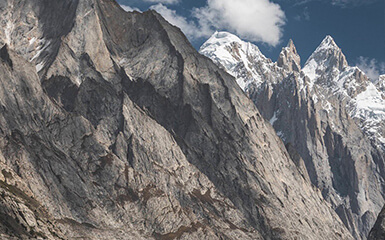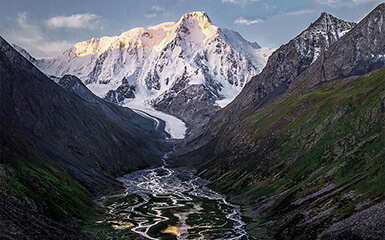The Tian Shan is a high mountain range about 2,450 km long, 400 km wide and up to 7439 m high in the north of the inner-Asian mountain system of High Asia. It separates the northern and southern parts of the greater Turkestan landscape and extends over the Central Asian states of Kazakhstan, Kyrgyzstan, Tajikistan and Uzbekistan as well as the Uyghur Autonomous Region of Xinjiang in the northwest of the People's Republic of China.
In 2013, the Tian Shan Mountains in Xinjiang in the People's Republic of China were declared a UNESCO World Heritage Site, followed in 2016 by the Western Tian Shan Mountains in the states of Kazakhstan, Kyrgyzstan and Uzbekistan.
The name of the mountain is “Heavenly Mountains” or, in other words, “Divine Mountains” or it is translated “God's Mountain”.
The distribution of plants in the Tian Shan is determined by the altitude zones. There is a different plant group at each altitude and this provides a vegetative variety. Between 1500-1800 meters, mountain slopes, plains, and semi-arid areas stand out; then there are drought tolerant ephedra bushes and short grasslands in these areas. The most common landscape in the Tian Shan is steppe and this plant group is located between 1050-3350 meters altitude. Forest areas follow steppe and meadow in God’s Mountains. Forest cover can be found at altitudes between 1500-3000 meters and forest areas are generally located on the northern slopes. At lower altitudes there are deciduous trees and mixed wild fruit trees. There are bald areas within the forest areas and subalpine meadows in the regions adjacent to the forest upper limit. These subalpine meadows are found on the most humid northern slopes above 3000 meters and there are lands considered as cold desert between 3400-3700 meters. The region has an astonishing ecological richness and its fauna is as unique as its flora. The great diversity of bird and mammal species has increased with the resettlement of human groups at lower altitudes. In addition to creatures such as foxes, wolves, and stoat, brown bears, mountain goats, roe deer, snow leopards and wild boars live among the forest and steppe areas of the mountain. There are also a few species of snakes and lizards.
Tien Shan is very rich and have a large amount of underground wealth. In particular, it contains most of the minerals, even most non-ferrous metals have large enough deposits to be mined and exploited commercially. Phosphate, mercury, lead, zinc etc. The region, which contains many precious metals, also contains rich oil, natural gas and coal deposits. The abundance of these resources and their commercial potential have led to the start of industrial enterprises, especially on the northern slopes in the east of the mountain range.


